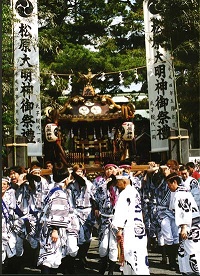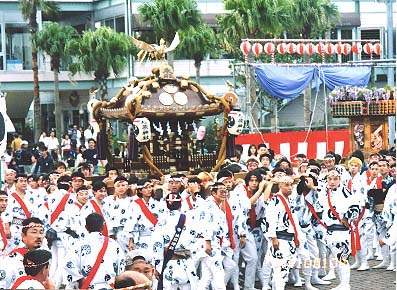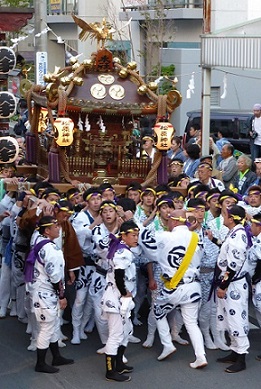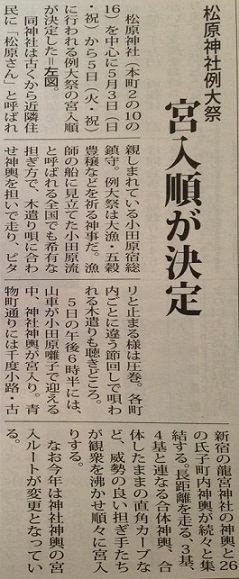

 小田原近隣地区では、神輿は一般的に茅ヶ崎を代表とする「どっこい」担ぎや、
東京の江戸前で担がれているのが一般的で、その影響もあって各町内神輿の若い衆の間
では「どっこい」「江戸前」で担ぎたがる者もありますが、松原神社の御魂が神輿に入った
例大祭においては、各町内共に「小田原流」で渡御する様に徹底している。
小田原近隣地区では、神輿は一般的に茅ヶ崎を代表とする「どっこい」担ぎや、
東京の江戸前で担がれているのが一般的で、その影響もあって各町内神輿の若い衆の間
では「どっこい」「江戸前」で担ぎたがる者もありますが、松原神社の御魂が神輿に入った
例大祭においては、各町内共に「小田原流」で渡御する様に徹底している。特に小田原流は神輿が走るという性質をもっている為、一ヶ所に長く滞在する状態が無い。 また神輿の移動範囲もかなり広範囲に渡り渡御を行う為、目的の町内の神輿を探すのは、 大変困難である。 There're some of shoulder style Mikoshi carring. The most popular carring style is Edo-mae(Tokyo style). And Kanagawa prefecture portable shrine have an original carring style Dokkoi(Kanagawa style). But Odawara has an exclusive carring style it's an Odawara style. Matsubara shrine festival makes it a rule to carry all portable shrines by Odawara style when shrines spirit comes into portable shrine. |
|
去る98年10月10日、横浜八景島シーパラダイスにて
走る「小田原流」神輿を披露する機会に恵まれ、小田原から
「松原神社」/「大稲荷神社」の二社の神輿渡御を行った。 担いだまま走る小田原流神輿は、日本全国でも大変珍しいもので、他 ではあまり耳にしない。 小田原では戦国時代にさかのぼる事、北條時代から既に漁師が神輿を担いで走る独特 の担ぎを行っており、数百年も変わる事無く子孫へ受け継がれて来ている。 At 10-Oct-1998, Matsubara portable shrine had announced Odawara style at "Yokohama Hakkei-jima sea paradaise". Matsubara and Dainari both Odawara representative portable shrines brought there in order to show very rare Odawara style. This rare style has continued for a long long time ago. |
 時は平成十年神無月の十の日、我が地八景島にて祭礼を奉ずるにあたり、
貴の国小田原の祭り勇壮にてみごととの噂聞き及び大いに拝見致したく
万難を配して迎えますれば是非お出かけ下さいませぬかとの申し出なり
その時の明神會の心境を歌にすれば、
時は平成十年神無月の十の日、我が地八景島にて祭礼を奉ずるにあたり、
貴の国小田原の祭り勇壮にてみごととの噂聞き及び大いに拝見致したく
万難を配して迎えますれば是非お出かけ下さいませぬかとの申し出なり
その時の明神會の心境を歌にすれば、「出し覚悟は有りにけり、堂々として了々」であったろう。 五百を数える男らが我先にと集まった。感涙である。 十の日朝光まぶしく快晴なり、両大社(松原神社並びに大稲荷神社)の御神輿を 乗せた神車は酒匂川を渡り粛々として東へ向う、感無量の旅立ちなり。 八景島は神地と化った荒波育ちの男らは大漁旗をたなびかせ走るは走るは 翔ぶごとく勇ましくきらめき立ち「板子一枚下は地獄でござる」(注1) の心意気が見ている者を強烈に引き付ける。 見たであろう神事の様を、見たであろう男の祭りの神髄を。 一代限りの祭りを奉じた男らに万雷の拍手鳴り止まず、今ひと度と声が飛ぶ、 赤いたすきに白地のゆかた、ゆかたの袖の浪ちどりが「皐月の頃においでなせー」 と、薄紅に染められし八景島を後にした。 帰郷の途につく男らは晴々としてすがすがしい。 これぞ松原神社風土史に遺しておきたき所行なりそれが叶わぬものならば 「五百の男ら勇ましく」と語り継ぎたき伝説なり。 At 10-Oct-1998, Yokohama Hakkei-jima sea paradaise was listened that Odawara Matsubara portable shrine is really brave very well therefore, they wanted to see it at once... After this, they requested Matsubara shrine to visit with a portable shrine to them. Then Matsubara shrine's people under the protection of the local deity thought it's okay... But Matsubara portable shrine has ever experienced to be brought outside of the city... In the morning of 10-October, it was a very good weather condition. Matsubara portable shrine and Dainari portable shrine are carried into a big truck in order to be brought. This is a really strong emotion. Matsubara and Dainari both portable shrines were run and run. Odawara region of the fisherman always have a spirit that the inferno under the bottom of a ship therefore both Mikoshi's form fascinated many audience. This style was a very strong and a mysterious rather than other Mikoshi carrying style. Maybe, audience didn't see this brave Mikoshi style before. Both Matsubara and Dainari shrine's people under the protecton of the local deity were seen off by many audience after the festival. Over 500 people under the protection of the local deity was really brave and the audience will never forget this event forever. |
| 元明神會事務局 下田 正治 著 |
| 注1:漁師は常に「船底一枚下は地獄」の観念を持っている事の意 |
 神輿の担ぎ方は「方言」等と同様に各地方によりまちまちです。良く知られている担ぎ方に「江戸前」が上げられます。
神輿の担ぎ方は「方言」等と同様に各地方によりまちまちです。良く知られている担ぎ方に「江戸前」が上げられます。小田原流は神輿の担ぎ棒は井形(4本棒)で江戸前と同様ですが、担ぎ方は大変異なり独特です。 もともと発祥は漁師が担いだと言われ、かけ声も全て漁師独特の網引きで行われます。また、漁木遣が掛けられ、木遣唄が終わると神輿が走る「つっかける」のが特徴です。 網引きのかけ声は、オイサー、オリャサー、とかけ声を発し、船の上から定置網を引きますが昔は現代の様に機械で簡単に網を引く訳ではありませんから、皆揃って網を引く為にかけ声を必要としました。また、徐々に網が上がってくると網を引く手もつかれてきますので、木遣唄がどんどん掛けられていきます。 また、小田原流で特徴があるのは走る時以外は平担ぎで通常歩行と同じといわれているが、実は神輿を左右にゆっくりと練る様は、船が沖合で波に揺られている様を模していて、実に優雅で見ている者の心を捉え、小田原流ならでわの担ぎ方の一つの特徴といえる。 戦国時代から江戸時代にかけて、小田原地方の漁業は飛躍的に発展したと言われる。江戸時代初めの漁業関係の記録を見ると、早川・山王原・酒匂・小八幡等に舟役が課せられた事が記されており、舟や漁民の数が増加した事が推測される。 また、1654年(承応三)の記録には、千度小路が早川村から漁獲高の三分の一の場代でうずわ網場を借りた事が記されている。 四艘張網(よそばりあみ)、鰤網(ぶりあみ)、棒受網(ぼうけあみ)、立網(たちあみ)、手繰網(てぐりあみ)、平目網(ひらめあみ)等網の種類も豊富である。 特にそのうち四艘張網(よそばりあみ)は根拵網が現れるまで最も有力な網として普及していたもので、四ツ手網のような四角い大網を海底に密着して敷設して、魚群が来るのを待ち、魚群が中に入ると網の四隅を持っている舟上の大勢の船子たちが、掛声も勇ましく網を引き上げると言うものである。 記録によれば、1680年代(貞享年間)には根府川から真鶴までの地先に十六畳も張られていた。 さて、山車の上で奏でる「小田原囃子」は広く近隣地区で囃され、遠くは神奈川県を越え静岡県まで伝わって今なお祭りで囃されています。ところが、神輿の小田原流はどういうわけかあまり近隣地区で担がれると言う事は聞きません。最近では小田原でも「江戸前」「どっこい」を規制し、小田原流を行う様に求める声が上がっています。  漁民木遣唄でも説明がある通り、漁師は船底一枚下は地獄の観念から漁木遣の唄の中に多く海路神の名を詠み込んでいるものもある。漁木遣で特に目立つのは風俗唄が多く、昔から漁が男の仕事である事を裏付けている。また、近年において、女性差別が叫ばれる世の中であっても、昔から変わらず神輿の木遣には風俗唄を交えて唄われ、昔の漁師の思いや、漁の厳しさを後世へ伝えていかなければなりません。
漁民木遣唄でも説明がある通り、漁師は船底一枚下は地獄の観念から漁木遣の唄の中に多く海路神の名を詠み込んでいるものもある。漁木遣で特に目立つのは風俗唄が多く、昔から漁が男の仕事である事を裏付けている。また、近年において、女性差別が叫ばれる世の中であっても、昔から変わらず神輿の木遣には風俗唄を交えて唄われ、昔の漁師の思いや、漁の厳しさを後世へ伝えていかなければなりません。例えば、「富士の白雪はよ〜、朝日で溶けるぞ」という色唄があるが、この唄の何処が色唄かお分かりでしょうか? 富士山は女性のそれを模しており、朝日は男性を模している。男性を見た事で濡れるという事を意味しているいわゆる、色唄である。 所で皆さん話は変わりますが、良く江戸前等では女性が神輿の上に乗っているものを見たことはありませんか?小田原流は走る為、神輿の上に人が乗る事は禁じられています(危険な為)が、他の担ぎ方等では多く女性が乗っています。 本来神輿は神様が乗っていますので、そこに人が乗る等言語同断なのですが、実は神聖な女性は上に乗る事が許されます。つまり神輿に乗っている女性は神聖「処女」である事が条件で、神輿の上に乗れると言う訳です。あまり年齢が行き過ぎて神輿の上に乗ると、担いでいる人からそのような眼差しで見られるので、最近では子供を上に載せるケースが目立っていると言う訳です。 ところで、処女か否かなんて誰が見極めるのでしょうか?(自己申告なのだろうか・・・) There're lots of carrying type for a portable shrine as well as dialect. Above all, Edomae is a very famous carrying style. Odawara style is the same assembling of lod Edomae but the carrying style is a different. According to legend, this style method was born by fisherman therefore all rhythm and shout are same for seine. It's used with Kiyari job song, portable shrine dash to the target after singing Kiyari job song. Originally, fishermen said, "Oisa--- Oryasa---" as they pull up the seine from sea, now all seine is pulled up by the machine automatically but they had pulled up these fishing net by their hands thus they needed Kiyari job song for making timing. Allegedly, Odawara region's fishing industry was growth at Edo era. There're many harbors near the cost of Odawara sea. According to legend, Sendokoji had rent fishing nets from Hayakawa town by the 30 percent of the catch of fish at 1654. Net name of "Yosobari net" was a very famous using in Odawara fishermen. It laid bottom of water and many fishermen pulled up it from boat when many fish were passing by the net. It's in a 1680, there're many catching net and seines laid between Nebukawa and Manazuru. So, Odawara bayashi that plays on a float is a very famous. This song spread from near the Odawara region to far of Shizuoka prefecture but portable shrine carrying style of Odawara style doesn't spread. Many city's portable shrines have made it a rule to carry by the Odawara style right now. By the way, have you seen some person ride on a portable shrine? Odawara style has prohibited riding on a portable shrine 'Cause it's too danger for dash but other carrying style portable shrines are able to ride on. Primarily, human never ride on its because the portable shrine is holy very well but only virgin women can ride on it. Recently, some of regions make children girl ridden on portable shrines. |
| Copyright(C)2022 Matsubara shrine All Rights Reserved. |
| Home | History | Event | Portable | Parishioner | Old Map | Kiyari Song | Novel | Greeting |